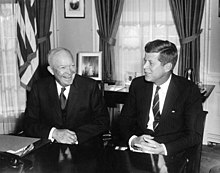 President-elect Kennedy (right) meets with outgoing president Dwight D. Eisenhower in the White House's Oval Office on December 6, 1960 | |
| Date of election | November 8, 1960 |
|---|---|
| Transition start | November 9, 1960 |
| Inauguration date | January 20, 1961 |
| President-elect | John F. Kennedy (Democrat) |
| Vice president-elect | Lyndon B. Johnson (Democrat) |
| Outgoing president | Dwight D. Eisenhower (Republican) |
| Outgoing vice president | Richard Nixon (Republican) |
| Leader of the transition | Clark Clifford |
| ||
|---|---|---|
| Transitions | ||
Planned transitions
|
||
| Related | ||
| ||
|---|---|---|
|
35th President of the United States
Tenure
Appointments
Presidential campaign Assassination and legacy
|
||
The presidential transition of John F. Kennedy began when he won the 1960 United States presidential election, becoming the president-elect of the United States, and ended when Kennedy was inaugurated at noon EST on January 20, 1961.
Kennedy placed Clark Clifford in charge of the transition effort. Outgoing president Dwight D. Eisenhower and his administration cooperated with President-elect Kennedy and his team on a number of aspects of the transition to facilitate the peaceful transfer of power. Ahead of the election, Clifford had been studying presidential transitions both independently on behalf of Kennedy and as part of a study being undertaken by the Brookings Institution.
At the time, United States presidential transitions were far less elaborate than they have since developed to be in subsequent decades. Kennedy's transition was a volunteer-run operation. Preparations for the transition started in advance of the election, with Clark Clifford working on behalf of Kennedy to studying past presidential transitions and Richard Neustadt doing the same on behalf of the Democratic National Committee (DNC). After the election, Clifford led the transition and Neustadt continued as an advisor. Top officials of Kennedy's transition were largely individuals that had also been part of his presidential campaign, including Robert F. Kennedy, Larry O'Brien, Kenneth O'Donnell, Pierre Salinger, Sargent Shriver, Stephen Edward Smith, and Ted Sorensen, and Dick Donahue. The transition was largely funded by the DNC.
While Eisenhower and Kennedy each thought negatively of the other at the time of the transition, the two intended to avoid a rough, tension-filled transition akin to the previous one between President Truman and Eisenhower. Ahead of the election, Kennedy's campaign and the administration of term-limited outgoing president Eisenhower had taken some actions to study past transitions and prepare for the 1960–61 presidential transition. Shortly after the election, Kennedy began receiving extensive daily briefings from the Central Intelligence Agency (CIA), as well as briefings from the Department of State. Eisenhower named White House Chief of Staff Wilton Persons as his administration's representative to the transition. Particularly during the later part of the transition, Kennedy's transition head Clifford and Persons both spoke on the phone and met in person with each other frequently.
© MMXXIII Rich X Search. We shall prevail. All rights reserved. Rich X Search



